In highway engineering, pavements should be constructed on subgrades with a known strength. The subgrade is the foundation or existing soil surface where the new highway will be built. Subgrade strength is normally described in terms of the CBR. The design idea for heavily trafficked roads is to improve the subgrade as needed and to establish a stable platform with the sub-base for the construction of the bound structural layer and surfacing above. In the long run, the capping and/or sub-base keep water out of the bound layers and offer a platform for compacting the bound layers.
The theory for both composite and flexible pavements is that the thickness of the sub-base/capping layer does not fluctuate with traffic, but rather with the strength of the subgrade. The thickness is the same in both types of roads.
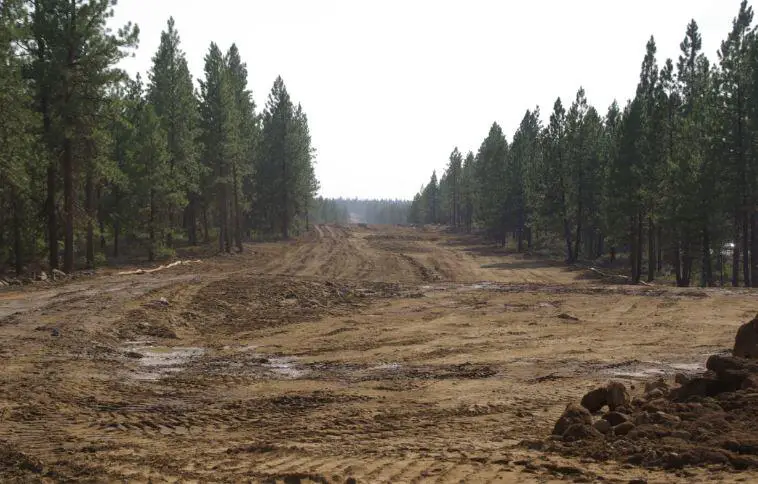
A pre-construction geotechnical site investigation shall be carried out for all sites prior to the start of any highway design/construction in order to assess a number of design issues, including the stiffness (CBR) of the material, its moisture sensitivity, and, if necessary, its suitability for earthworks and stabilisation to form a capping layer, sub-base, or road base material.
Despite problems in measurement, particularly on mixed fine and coarse graded soils and when moisture effects are considered, the California Bearing Ratio (CBR) remains the greatest predictor of soil strength. A method based on the Portable Dynamic Plate is available for measuring the stiffness of the sub-grade under dynamic loading. This is especially useful when a road is being widened such that the foundation is at or near equilibrium, while for new roads, additional approaches will be required to calculate equilibrium CBR values.
Regardless, any site investigation can only sample the soils at discrete areas inside the site. Variability is unavoidable, and it should be factored into the work’s design. A competent Geotechnical Engineer can provide guidance on the expected range of CBR values if necessary.
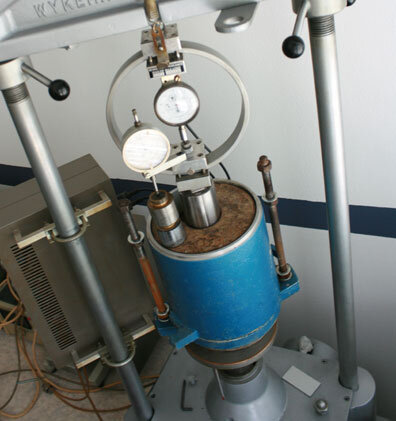
Aside from determining design CBR values for both short and long-term characterization of subgrade performance, several other elements might affect subgrade performance and must be considered during the design stage. The following are examples of typical issues to be addressed:
a) Water table depth/perched water tables
b) Chemical contamination risk assessment
c) Control of fine-grained soil piping
d) The possibility of encountering loose Made Ground.
a) The requirement for foundation soils to be improved on the ground (e.g. soft Alluvium, loose made ground etc.)
f) The risk of collapse settlement of dry engineered fills
g) The possibility of landslides.
h) The possibility of subsurface caves, deneholes, and so forth.
I The effect of nearby developments on locations with soft alluvium.
j) The occurrence and handling of subgrade solution characteristics.
k) Solution characteristics below drainage runs are treated.
l) Treatment and frequency of other subgrade soft spots.
m) Frost sensitivity of the subgrade.
n) Risks of differential settlement/need for ground improvement.
o) Subgrade soil chemistry if in-situ lime/cement stabilisation is considered.
p) The ability of over-consolidated clays to shrink and expand. (Especially where trees have been destroyed)
q) The possibility of open cracks in the underlying rock.
r) The possibility of soft clay layers in granular soil.
The strength of a subgrade may be defined in terms of the soaked CBR. Subgrade strength classification in terms of CBR is given in the Table below;
| Soaked CBR | Strength Classification | Comments |
| < 1% | Extremely weak | Geotextile reinforcement and separation layer with a working platform typically required. |
| 1% – 2% | Very weak | Geotextile reinforcement and/or separation layer and/or a working platform typically required. |
| 2% – 3% | Weak | Geotextile separation layer and/or a working platform typically required. |
| 3%–10% | Medium | Geotextile separation layer and/or a working platform typically required. |
| 10% – 30% | Strong | Good subgrade to Sub – base quality material |
| > 30% | Very Strong | Sub – base to base quality material |
Selection of Method for Determination of CBR
The method for determining CBR should be chosen depending on the scale of the scheme, the precision required, and the likely soils encountered. Special precautions are required to provide adequate foundation support for CBR less than 2%.
The strength of most soils is highly dependent on moisture content. Some soils experience a rapid loss of strength as the moisture content increases. On such soils, structure protection as described in the Specification for Highway Works is very critical, as is a conservative approach when considering the effect of subgrade drainage.
For design purposes, two scenarios must be considered: the likely CBR at the time of construction and the long-term equilibrium value. Both of these are essential for design purposes. If the ‘as found’ CBR at the time of construction is less than that determined during the site investigation, a change in foundation layer thickness may be required.
The plasticity index should be computed for cohesive soils, and the description of the soil type from a grading examination of a bulk sample, as well as some knowledge of the probability of saturation in the future, should be examined for other soils. The table below can be used to approximate the CBR based on this information.
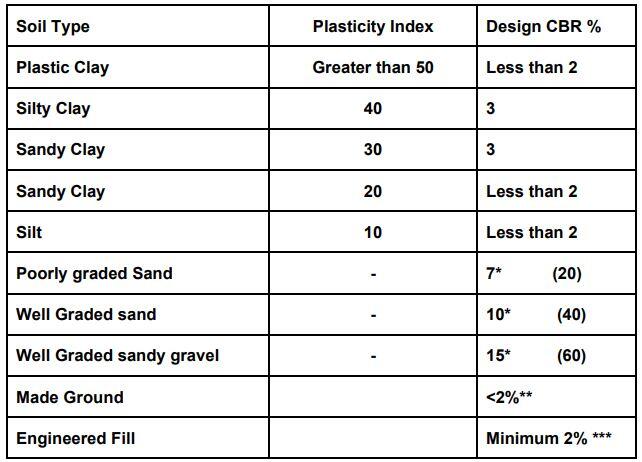
Methods of Determination of CBR
CBR’s performed upon pot samples
Advantages
(i)It enables the evaluation of a soil’s CBR at various levels of saturation (CBRs, soaked/unsoaked)
Disadvantages
(i) Considerable disturbance is created during the sample operation, which has a significant impact on the test results.
(ii) Requires a large trial pit.
Plastic and Liquid Limits
Advantages
(i) It enables a lower bound estimate of the CBR under recompacted circumstances for a wide range of effective stresses (i.e. construction conditions)
Disadvantages
(i) Unless standard graphics are utilized, the analytical approach is costly.
(ii) The typical graphs are based on the worst-case scenario.
(iii) Can only be utilized on soils containing cohesive material
(iv) Can be difficult to evaluate on granular and cohesive material mixtures
Soil Assessment Cone Penetrometer (MEXE Probe)
Advantages
(i) It is simple and affordable to carry out.
Disadvantages
(i) Correlation dependant
(ii) Only offers the current CBR value
(iii) Insensitive to the influence of the soil’s microstructure
(iv) It is not suitable for usage in stony soils.
Measurement of Shear strength (hand vane/Triaxial tests)
Advantages
(i) The hand vane is a quick and low-cost method of measuring undrained shear strength.
(ii) Triaxial measurements of undrained shear strength take into consideration the soil microstructure
(iii) For recompacted subgrades, remolded tests provide a lower bound.
Disadvantages
(i) Only offers the existing CBR value when using the hand vane
(ii) Triaxial measurements are somewhat expensive to perform, and sample and testing time might be lengthy
(iii) It is dependent on correlation although this has a theoretical basis
(iv) can only be applied for cohesive soils.
In-situ CBR
Advantages
(i) Realistic CBR measurement
(ii) Takes into account the macrostructure of the soil account
(iii) can be used to determine the present chalk value in chalks
Disadvantages
(i) Expensive to complete
(ii) Only offers the present CBR value
(iii) It is difficult to perform beneath the existing ground surface
(iv) Not recommended for coarse granular soils.
Laboratory compaction test
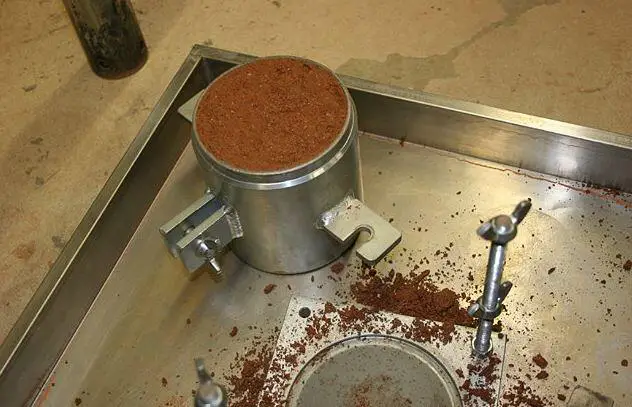
Advantages
(i) Calculates the CBR of remoulded soils at various moisture levels.
Disadvantages
(i) Insensitive to soil macrostructure impacts
(ii) Expensive to do
(iii) Requires a big sample
(iv) variable outcomes with coarse granular soils
Conclusion
CBR measurements are used to determine the current subgrade strength and to forecast the worst-case scenario for future service inside the pavement. In actuality, the current value may underestimate the subgrade’s strength at the time of construction because pessimistic conditions may not be present at the time of building, such as during summer construction. The current value, on the other hand, could have been taken in the summer and the plan built in the winter, when the subgrade may be weaker due to the moisture accumulating at that time of year.
As a result, it’s critical to think about the implications of the site investigation results in relation to those at the time of building. Unfortunately, there are no “hard and fast” guidelines, therefore field data may need to be interpreted by a professional. To develop an interpretative statement on the equilibrium CBR for design purposes, local knowledge of the effect of moisture on the relevant soil and the compaction/moisture content vs CBR connection should be combined with laboratory experiments. It will be necessary to make a request for this. Other elements impacting the performance of the subgrade, such as drainage and the possibility of foundation material settlement, must also be considered in the design.

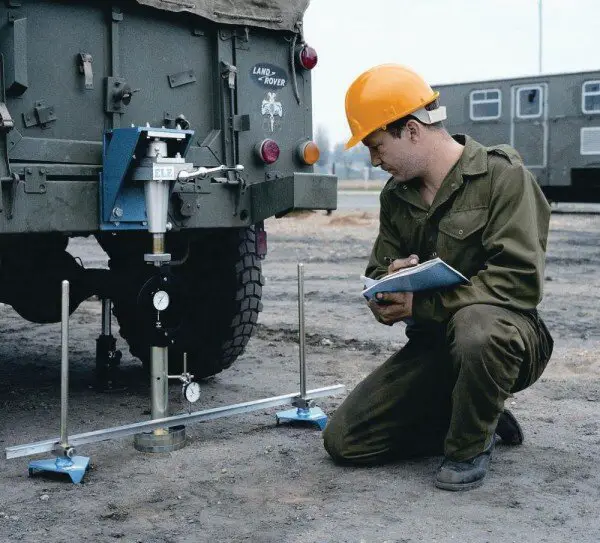
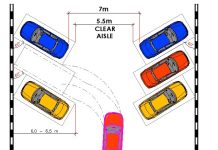




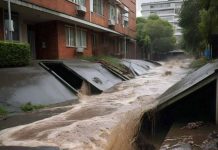
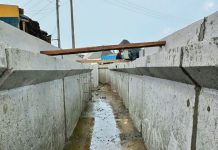


Nice to here more from you, keep it up